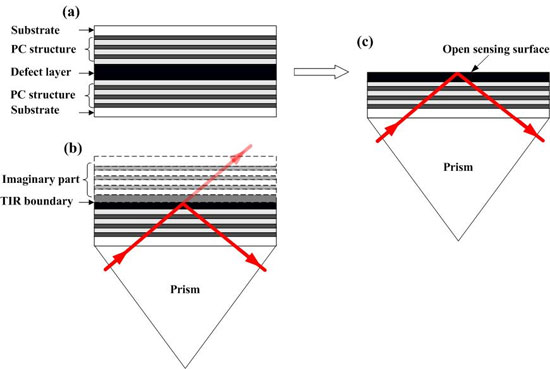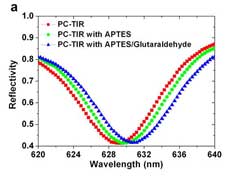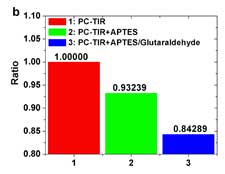There is a great demand for high sensitive, high accurate and high throughput bioassay analytical instruments that can provide insights on a molecular basis into critical biological processes. Our group has proposed and demonstrated a novel bioassay sensor using a one-dimensional photonic crystal (PC) structure in a total internal reflection (TIR) geometry (PC-TIR sensor). This configuration forms a microresonator in the top layer and utilizes enhanced evanescent electric field to detect the presence of analytes on an open sensing surface, which offers unique advantages for detecting very low concentrations of biomolecules as well as studying real-time biomolecular affinity and binding kinetics without fluorescent labels.
When molecules are bound to the sensing surface, the response of PC-TIR sensor is characterized by the shift of a resonant dip. This shift is monitored by both spectral measurement and differential intensity measurement. We investigated the detection sensitivity of this PC-TIR sensor by binding thin biomolecular layers (aminopropyltriethoxysilane (APTES) and glutaraldehyde (GA)) on the sensing surface. A significantly improved detection limit was theoretically predicted and experimentally shown for the PC-TIR sensor in comparison with that of state-of-the-art surface plasmon resonance (SPR) sensors.
Fig.1 Principle of a PC-TIR sensor
Fig.2 Resonance dip shifts (a) and differential intensity ratio changes (b) with binding of bioassay
[1] Y. B. Guo, C. Divin, A. Myc, F. L. Terry, Jr., J. R. Baker, Jr., T. B. Norris and J. Y. Ye, “Sensitive bioassay using a photonic crystal structure in total-internal-reflection geometry,” (To be submitted) (2008).
[2] Y. B. Guo, J. Y. Ye, C. Divin, A. Myc, J. R. Baker, Jr. and T. B. Norris, “Optical Biosensor based on One-Dimensional Photonic Crystal in a Total-Internal-Reflection Geometry,” (submitted to CLEO)(2008).



